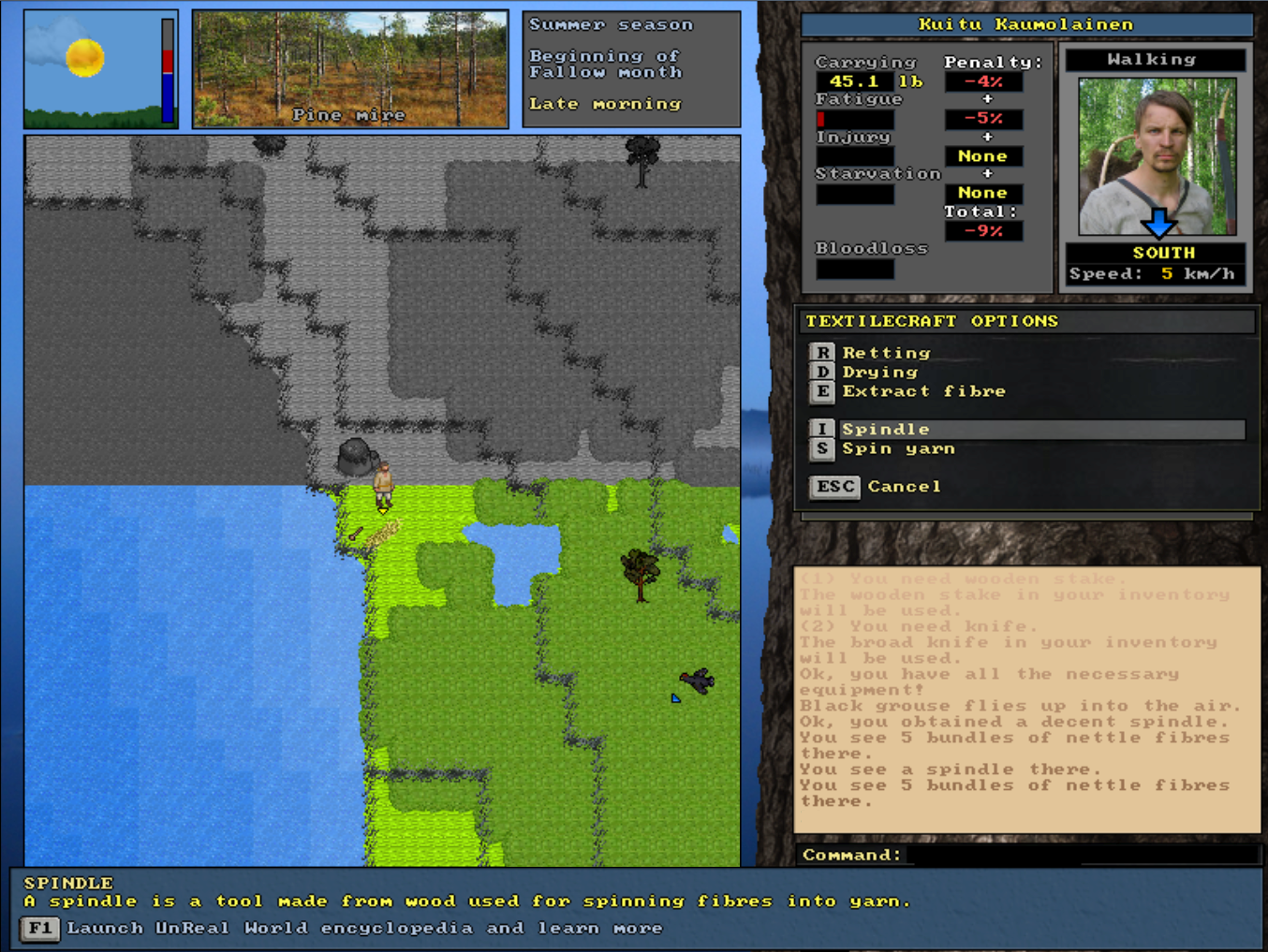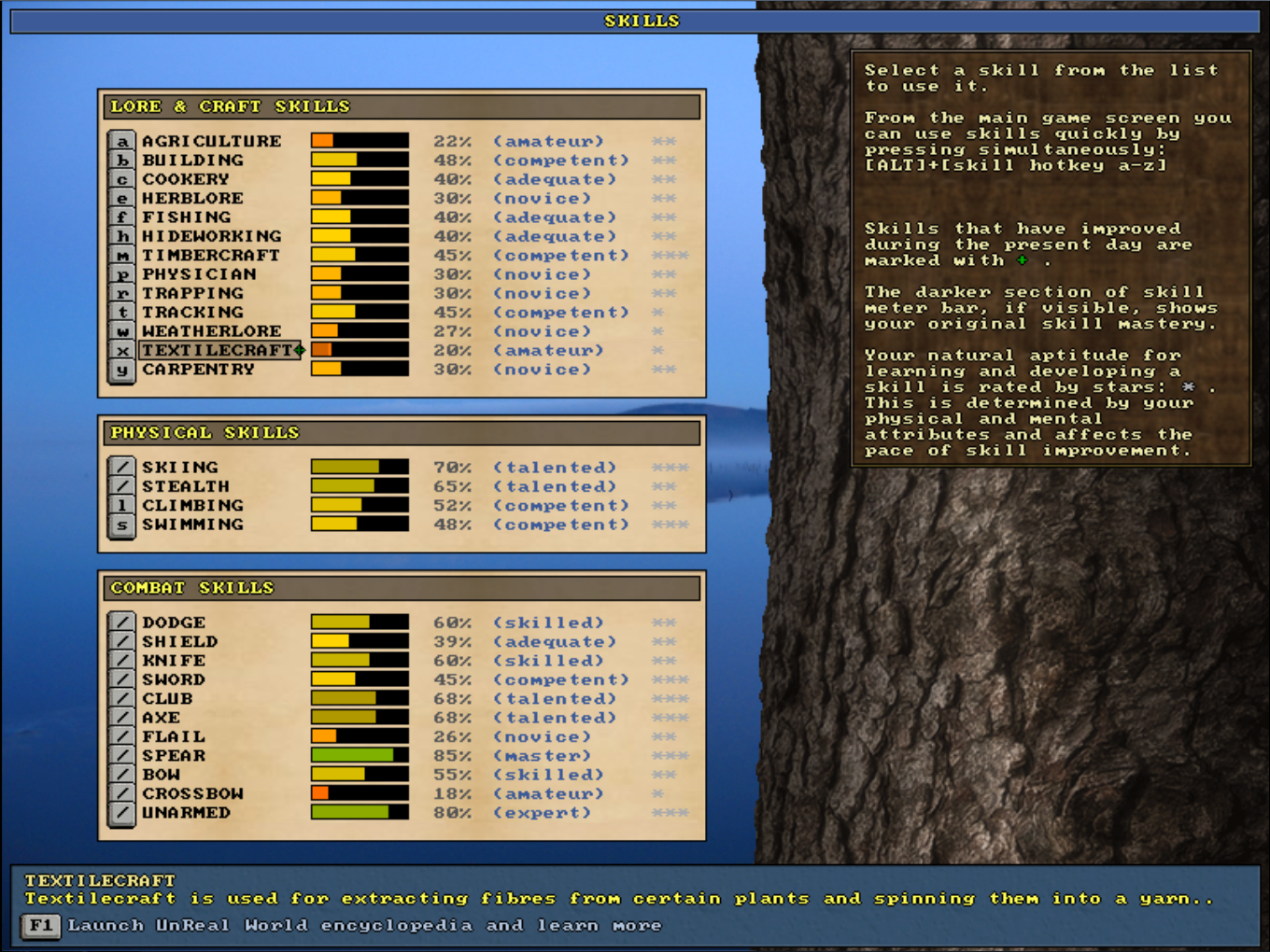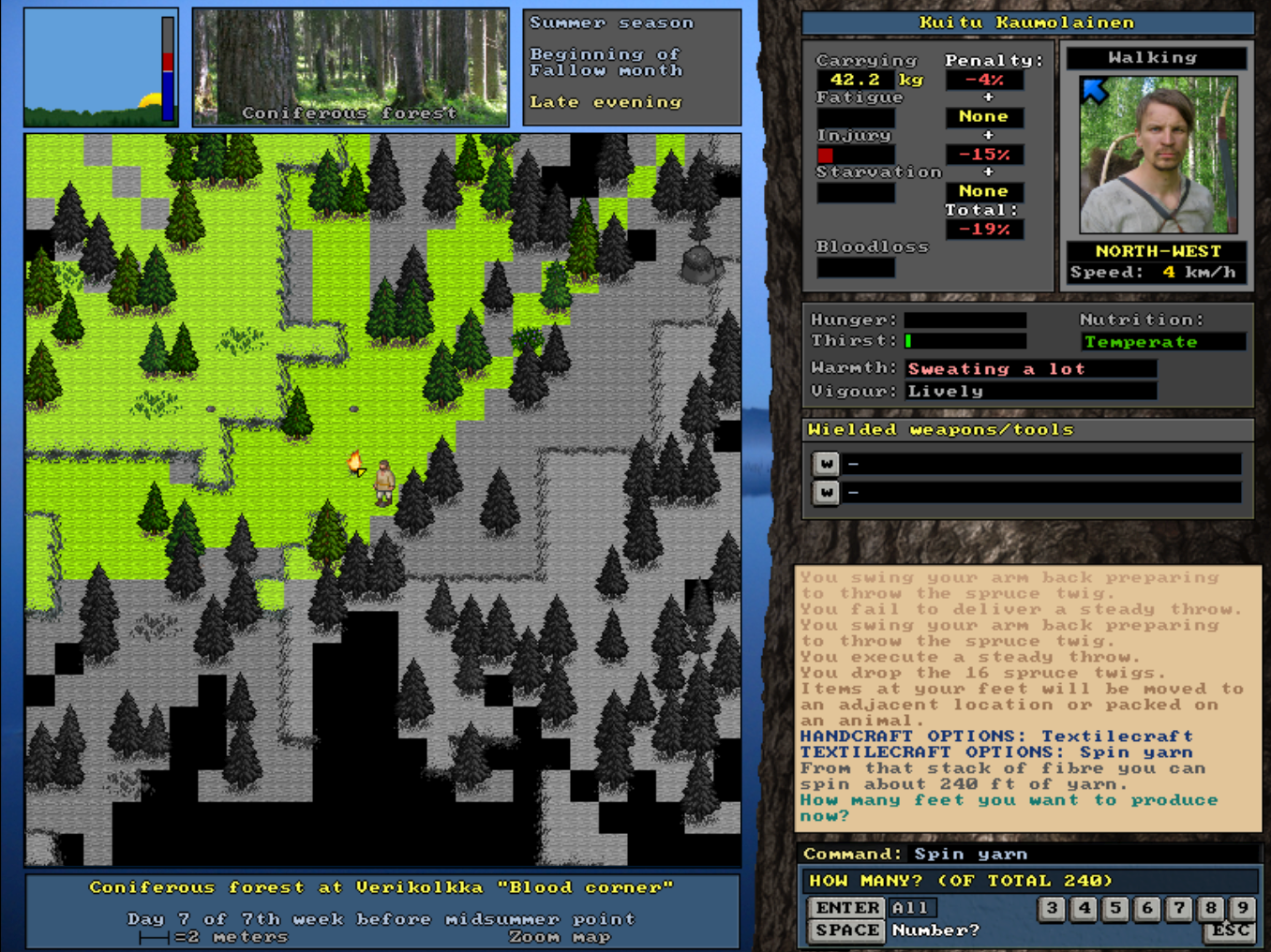See likes given/taken
| Post info | No. of Likes |
|---|---|
|
Putting Out Fires
Title. Currently, afaik, the only way to stop a fire from spreading along a fence or a wall is to deconstruct any wooden structures in the fire's path. We should be able to put out fires by standing next to the fire with a container full of water, "a"->apply the tub/skin/etc. and have this either reduce the fire's size or put it out entirely, depending on how much water was in the container. February 04, 2021, 04:59:37 PM |
1 |
|
Re: Putting Out Fires
You can kick fences down faster than you can deconstruct them. Walls, no luck. Zooming out, walking away and hoping for best works ok-ish too. But yes, dousing with water would be nice. Applying shovel to cover low fires with sand (or wet dirt) would be welcome too. February 05, 2021, 03:57:27 AM |
1 |
|
Auto-cutting and other tying equipment additions
Bunch of tying equipment related additions are being worked on. It's a sector of code where meandering from one feature to another is quite easy, and sometimes required, but these main blocks are on the table right now: * Auto-cutting tying equipment to required lengths in crafting/building. For example: If you'd need say 5 feet of cordage and select a 15 feet rope for the job it's auto cut to required length and the remaining portion (10 feet) stays in your inventory. With this new condition in effect the cordage minimum lengths however will come into play. So with the above example you need to select 5 feet long cordage minimum, and would need to join the cordage manually first if only shorter pieces are available. In any case it makes more sense, and is less of micro-management, than the current system. * Few cordage classifications as crafting requirements Currently the actual tying equipment properties aren't that much checked in crafting processes. Almost any tying equipment works for any job. Now we'll see about adding a few requirement classifications such as "strong cordage", "thin cordage" or "thread". These would work so that for example "strong cordage" requirement accepts ropes and spruce withes - which are the strongest type of withe. Crafting for example a raft would required "strong cordage" for tying, and now you could use ropes and spruce withes that, but not the other kind of cordage outside the classification. Arrow making would require "thread" type cordage. Loop snares could be only made from "thin cordage". And so on. Classification is still under construction so different wordings can be suggested, and ideas posted here. It's can be quite tricky to find terms that would open up easily, and not to end up with too many categories. Naturally the game will also display messages about this-and-that requirement accepting this-and-that items. Strong cordage - ropes, spruce withes Thin cordage - strings, cords Thread - yarns (or sinew threads, whenever we get there) etc. * Nettle processing We'll add the steps to be able to make nettle yarn, and then see where it goes after it's working ok. In addition to retting and beating the fibres out of the stems, there would be preferably also the easy early summer method where you can extract the fibres by hand and make primitive yarn fast - eg. for survival fishing rod line. February 15, 2021, 01:29:40 PM |
1 |
|
Re: Installing game on Linux.
GDebi helped, thanks!
February 20, 2021, 05:21:40 PM |
1 |
|
'Asentokuusi' - simple shelter under a leaning spruce tree
A few essential wilderness accommodation options for rough wanderers are coming up. 'Asentokuusi' (can be freely translated as "post spruce") was the simplest form of shelter for resting and spending a night protected from the elements - and in the next patch we'll be featuring a possibility to set up a 'post spruce'. Post spruce is made simply by felling a young spruce to lean against another spruce tree. Some of the lowest twigs are removed to create space, and these are then laid on the ground for some insulation and cushion. Simple as that. This was the usual method of spending a night in the wilderness condition when more permanent camp wasn't necessary. Setting up a post spruce will found in "Building options", and it does felling the tree and covering the ground with twigs all together. Tools needed for the process are the same as for felling young trees in general. With this addition we'll also feature general usage of spruce twigs as ground cover for insulation. If there are no furs to cover yourself into sleeping on spruce twigs, instead of bare ground, now keeps you a bit more warm during cold nights. These are future additions, not yet functional in current version 3.63. March 12, 2021, 06:39:15 PM |
1 |
|
Re: Active hunting tips?
Quote If i shoot a animal or human that's at south-east, north-west the range is doubled? Like if the diagonal tile be 4m instead of 2m when it's a horizontal or vertical tile? I just checked the code. Range is not doubled, yet it varies based on the angle you are aiming at. For example, if your target is 6 tiles to the south and 2 tiles to the east, the actual distance is about 6.32 tiles. March 16, 2021, 05:50:09 PM |
1 |
|
Re: Active hunting tips?
I think PALU got it right. Technically speaking: Character and NPC movement code uses integers, but missile trajectory code is based on floating-point calculations.
March 17, 2021, 08:07:27 AM |
1 |
|
A very draft of textilecraft -- fibre processing on its' way
So we're adding fibre processing, from harvested plants into yarn, starting with nettles. It's a complex feat(ure) all-in-all and the things briefed here can change as we proceed. Now we're in the middle of brainstorming, study, coding and testing the initial mechanics - and also making changes to existing stuff to the extent that allows this type of new material processing in the first place. Starting with nettles we'll add few new habitats (ponds and wetlands) for them so that the newly featued usefulness will be practical in the wilderness conditions. Nettle harvesting also needs to be changed so that they can be harvested way earlier than currently, without seeds naturally, but in good length for fibre extracting. Fibres obtained will be probably categorized as PLANT item type, for easier spotting and selection from the inventory. For all the fibre processing and spinning yarn it's likely that we'll feature a completely new skill: textilecraft. The fibre processing in general will go through retting, drying and extracting fibres. We'd like to feature water retting based on the temperature, so it can be faster or slower depending on the weather (ie. water temperature), and becoming impossible in the freezing weather. We'd also like to make it possible to extract fibres from (fresh) nettles simply by hand without retting process required. It takes some time, but that's how you would craft a fishing line in the wilderness within few hours. For producing larger quantities of fibres the water retting would be the way to go, of course. Fibres can be spun into yarn either by hand, or with a spindle. The both options will be available. Crafting a spindle is simple, but the actual spinning is something you need to practise. Textilecraft skill would come in handy there, as the beginners surely don't produce yarn all that fast at all. That's some of the to-dos (and actually some dones also) from top of my head to come up with satisfying fibre processing. With this addition I found it better to proceed kind of backwards... So at first I've got some (magically generated) nettle fibre, and a spindle - a new craftable item. Textilecraft menu is set up with the initial options. Retting, drying and extracting are mere placeholders, but spinning yarn is being coded now. Productions times and yield and internal properties of the bundles of fibre, and yarns are on the table. After the spinning code is ready, it's time to concentrate on the preceeding steps. Here's a very draft screenshot where I'll try to code Kuitu Kaumolainen through spinning his first nettle yarn. There's bundle of nettle fibres and spindle on the ground.  These are future additions - not yet functional in current version 3.63. March 17, 2021, 11:04:37 AM |
1 |
|
Textilecraft continued
Fibre processing is on the table. We'll be featuring a new skill, TEXTILECRAFT, which determines the success and time required for several work phases of processing fibres into yarn. For migrated characters textilecraft will be initiated to the cultural defaults upon first load. All the textilecraft options - retting, drying, spinning etc. - will be found in the general [M]ake menu, and can be also accessed simply by using the skill. Spinning fibres into yarn is now pretty much competely done, the productions times and yarn yield carefully considered. Textilecraft mastery, and using a spindle or not, naturally affects to outcome and spinning times. The actual mechanics of getting fibres spun works so that when "spin yarn"-textilecraft option is chosen you'll be asked to choose from the inventory which fibres to spin. After that you'll be informed how much yarn you can expect to get from that, and can select how much you wish to produce now. And then the spinning starts, with a spindle or by hand. During the playtest I've spun (magically generated) nettle fibres, but we'll be also making hemp as fibre source. The fibre processing keeps track of the master plant so the plant identity is easily turned into resulting yarn. Nettle yarn, hemp yarn, and so on. Flax is naturally something to think of. We'll see if it fits into this version. Now as the yarn generation from the fibres is working we'll be also adding yarns as village items, so instead of spinning your own you can also trade your yarn from some cultures. The big question still being pondered is how expensive yarn should be? It's hard work to spin yarn with a spindle, takes about minute to produce three feet (or a meter). Next up, coding and testing the preceeding steps; retting and drying and extracting fibres. A few screenshots follow.  Skills screen with TEXTILECRAFT in place.  After choosing the bundle of fibre to spin there's dialog asking how much of yarn Kuitu Kaumolainen wishes to produce on this go. March 24, 2021, 07:08:44 PM |
1 |
|
Fibre processing continues with retting and some spin-off features
By now spinning code is all done and tested and polished, and we're happily able to spin both nettle and hemp yarn. With some new flora_*.txt tags added it's actually possible to add fibre yield for any flora_*.txt plant, although the textilecraft processes are modelled for nettle and hemp. But yes indeed for example flax as a new fibre source can be added relatively easily. We've also added straw, a mere stalk of certain plants, as a new item type. Straws will be a byproduct of threshing plants such as nettles and hemp, but with a flora_ tag of their other plants can be also given straw yield. Straws don't (yet) have specific use of their own but do serve as material for fibre processing. Straw items were added for the sake of being able to thresh valuable plants for seeds and leaves first, and still have the straw remaining for fibre. And now there's "retting" added for textilecraft options. It's a process for separating the fibres from the stalks of harvested plants, and the first and foremost option of them all. Retting is done by soaking the plants in the water for several days. The soaking needs to be done by open water and the sufficient soaking time depends on the water temperature, varying from 5 to even 25 days. The warmer the water, the faster the retting process is. The retting doesn't occur at all in very cold water so it can't be done for example in the winter. However, nettles are a speciality and you can peel fibres from them by hand without retting, but it's relatively slow and mostly used only if small amount of yarn needs to be spun. Now the remaining steps to do on our way to completely finished textilecraft system for fibre processing would be drying the retted plants, and extracting the fibre. So let's continue ... These are future additions - not yet functional in current version 3.63. April 19, 2021, 04:48:22 PM |
1 |


